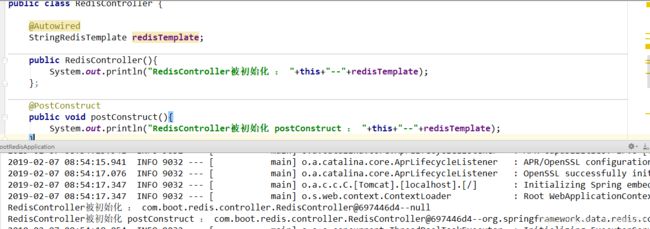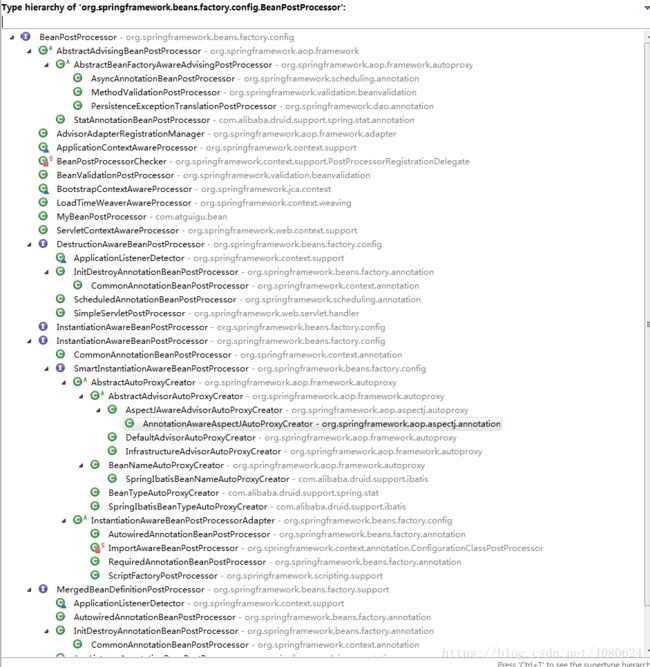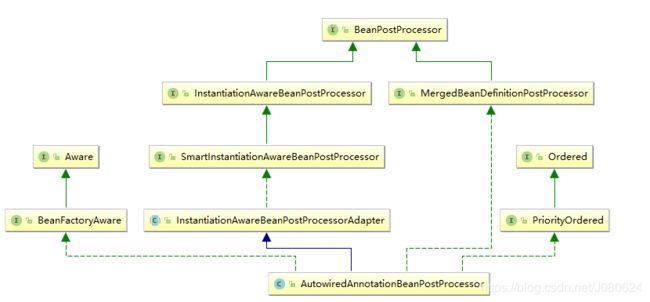Spring - bean的初始化和销毁几种实现方式详解
Bean的生命周期 : 创建bean对象 – 属性赋值 – 初始化方法调用前的操作 – 初始化方法 – 初始化方法调用后的操作 – …-- 销毁前操作 – 销毁方法的调用。
【1】init-method和destroy-method
两种方式,xml配置和注解。
① xml配置:
② 注解
@Scope("singleton")
@Lazy
@Bean(name="person",initMethod="init",destroyMethod="cleanUp",
autowire=Autowire.BY_NAME)
public Person person01(){
return new Person("lisi", 20);
}
详见: https://blog.csdn.net/j080624/article/details/79779571。
单实例bean在容器创建完成前会进行创建并初始化,在容器销毁的时候进行销毁。多实例bean(scope=prototype)在第一次获取该bean实例时才会创建并初始化,且容器不负责该bean的销毁。
【2】InitializingBean 和DisposableBean
InitializingBean 接口如下:
- 在BeanFactory设置完bean属性后执行
需要被bean实现的接口,一旦bean的属性被BeanFactory设置后需要做出反应:
如,执行自定义初始化,或者仅仅是检查是否设置了所有强制属性。
实现InitializingBean 的可替代方式为给bean指定一个自定义的init-method,例如在一个xml bean 定义中。
public interface InitializingBean {
void afterPropertiesSet() throws Exception;
}
在bean的属性设置之后进行操作,不返回任何值但是允许抛出异常。
DisposableBean接口如下:
被bean实现的接口,在销毁时释放资源。
如果销毁一个缓存的单例,一个BeanFactory 可能会调用这个销毁方法。
在容器关闭时,应用上下文会销毁所有的单例bean。
一种替代实现DisposableBean 接口的方案为指定一个自定义的destroy-method方法,例如在一个xml bean定义中。
public interface DisposableBean {
void destroy() throws Exception;
}
在Bean销毁的时候调用该方法。
自定义bean实现上述两个接口
@Component
public class Cat implements InitializingBean,DisposableBean {
public Cat(){
System.out.println("cat constructor...");
}
@Override
public void destroy() throws Exception {
// TODO Auto-generated method stub
System.out.println("cat...destroy...");
}
@Override
public void afterPropertiesSet() throws Exception {
// TODO Auto-generated method stub
System.out.println("cat...afterPropertiesSet...");
}
}
测试结果如下:
cat constructor...
cat...afterPropertiesSet...
容器创建完成...
四月 08, 2018 6:35:46 下午 org.springframework.context.annotation.AnnotationConfigApplicationContext
doClose
信息: Closing org.springframework.context.annotation.AnnotationConfigApplicationContext@11028347:
startup date [Sun Apr 08 18:35:46 CST 2018]; root of context hierarchy
cat...destroy...
【3】@PostConstruct和@PreDestroy
使用JSR250规范定义的两个注解:
- @PostConstruct: PostConstruct注解作用在方法上,在依赖注入完成后进行一些初始化操作。这个方法在类被放入service之前被调用,所有支持依赖项注入的类都必须支持此注解。
- @PreDestroy:在容器销毁bean之前通知我们进行清理工作
自定义类使用上述两个注解
@Component
public class Dog implements ApplicationContextAware {
//@Autowired
private ApplicationContext applicationContext;
public Dog(){
System.out.println("dog constructor...");
}
//对象创建并赋值之后调用
@PostConstruct
public void init(){
System.out.println("Dog....@PostConstruct...");
}
//容器移除对象之前
@PreDestroy
public void detory(){
System.out.println("Dog....@PreDestroy...");
}
@Override
public void setApplicationContext(ApplicationContext applicationContext) throws BeansException {
// TODO Auto-generated method stub
this.applicationContext = applicationContext;
}
}
测试结果如下:
dog constructor...
Dog....@PostConstruct...
容器创建完成...
四月 08, 2018 6:42:11 下午 org.springframework.context.annotation.AnnotationConfigApplicationContext
doClose
信息: Closing org.springframework.context.annotation.AnnotationConfigApplicationContext@11028347:
startup date [Sun Apr 08 18:42:10 CST 2018]; root of context hierarchy
Dog....@PreDestroy...
【4】BeanPostProcessor-Bean后置处理器
在bean初始化前后进行一些处理工作;
- postProcessBeforeInitialization:在初始化之前工作
- postProcessAfterInitialization:在初始化之后工作
其接口源码如下:
/**
* Factory hook that allows for custom modification of new bean instances,
* e.g. checking for marker interfaces or wrapping them with proxies.
*
* ApplicationContexts can autodetect BeanPostProcessor beans in their
* bean definitions and apply them to any beans subsequently created.
* Plain bean factories allow for programmatic registration of post-processors,
* applying to all beans created through this factory.
*
*
Typically, post-processors that populate beans via marker interfaces
* or the like will implement {@link #postProcessBeforeInitialization},
* while post-processors that wrap beans with proxies will normally
* implement {@link #postProcessAfterInitialization}.
*
* @see InstantiationAwareBeanPostProcessor
* @see DestructionAwareBeanPostProcessor
* @see ConfigurableBeanFactory#addBeanPostProcessor
* @see BeanFactoryPostProcessor
*/
public interface BeanPostProcessor {
/**
* Apply this BeanPostProcessor to the given new bean instance before any bean
* initialization callbacks (like InitializingBean's {@code afterPropertiesSet}
* or a custom init-method). The bean will already be populated with property values.
* The returned bean instance may be a wrapper around the original.
* @param bean the new bean instance
* @param beanName the name of the bean
* @return the bean instance to use, either the original or a wrapped one;
* if {@code null}, no subsequent BeanPostProcessors will be invoked
* @throws org.springframework.beans.BeansException in case of errors
* @see org.springframework.beans.factory.InitializingBean#afterPropertiesSet
*/
Object postProcessBeforeInitialization(Object bean, String beanName) throws BeansException;
/**
* Apply this BeanPostProcessor to the given new bean instance after any bean
* initialization callbacks (like InitializingBean's {@code afterPropertiesSet}
* or a custom init-method). The bean will already be populated with property values.
* The returned bean instance may be a wrapper around the original.
*
In case of a FactoryBean, this callback will be invoked for both the FactoryBean
* instance and the objects created by the FactoryBean (as of Spring 2.0). The
* post-processor can decide whether to apply to either the FactoryBean or created
* objects or both through corresponding {@code bean instanceof FactoryBean} checks.
*
This callback will also be invoked after a short-circuiting triggered by a
* {@link InstantiationAwareBeanPostProcessor#postProcessBeforeInstantiation} method,
* in contrast to all other BeanPostProcessor callbacks.
* @param bean the new bean instance
* @param beanName the name of the bean
* @return the bean instance to use, either the original or a wrapped one;
* if {@code null}, no subsequent BeanPostProcessors will be invoked
* @throws org.springframework.beans.BeansException in case of errors
* @see org.springframework.beans.factory.InitializingBean#afterPropertiesSet
* @see org.springframework.beans.factory.FactoryBean
*/
Object postProcessAfterInitialization(Object bean, String beanName) throws BeansException;
}
自定义MyBeanPostProcessor实现该接口:
/**
* 后置处理器:初始化前后进行处理工作
* 将后置处理器加入到容器中
* @author lfy
*/
@Component
public class MyBeanPostProcessor implements BeanPostProcessor {
@Override
public Object postProcessBeforeInitialization(Object bean, String beanName) throws BeansException {
// TODO Auto-generated method stub
System.out.println("BeanPostProcessor.postProcessBeforeInitialization..."+beanName+"=>"+bean);
return bean;
}
@Override
public Object postProcessAfterInitialization(Object bean, String beanName) throws BeansException {
// TODO Auto-generated method stub
System.out.println("BeanPostProcessor.postProcessAfterInitialization..."+beanName+"=>"+bean);
return bean;
}
}
BeanPostProcessor原理
AbstractAutowireCapableBeanFactory中关于bean和BeanPostProcessor执行次序由上到下
//给bean进行属性赋值
populateBean(beanName, mbd, instanceWrapper);
initializeBean
{
applyBeanPostProcessorsBeforeInitialization(wrappedBean, beanName);
invokeInitMethods(beanName, wrappedBean, mbd);
//执行自定义初始化
applyBeanPostProcessorsAfterInitialization(wrappedBean, beanName);
}
【5】Spring底层使用BeanPostProcessor
Spring框架底层存在大量BeanPostProcessor,如下图:
示例一 :BeanValidationPostProcessor是处理bean校验
其Javadoc如下:
/**
* Simple {@link BeanPostProcessor} that checks JSR-303 constraint annotations
* in Spring-managed beans, throwing an initialization exception in case of
* constraint violations right before calling the bean's init method (if any).
*
* @author Juergen Hoeller
* @since 3.0
*/
public class BeanValidationPostProcessor implements BeanPostProcessor, InitializingBean {
private Validator validator;
private boolean afterInitialization = false;
//...
}
示例二:ApplicationContextAwareProcessor帮助获取容器上下文
其Javadoc如下:
/**
* {@link org.springframework.beans.factory.config.BeanPostProcessor}
* implementation that passes the ApplicationContext to beans that
* implement the {@link EnvironmentAware}, {@link EmbeddedValueResolverAware},
* {@link ResourceLoaderAware}, {@link ApplicationEventPublisherAware},
* {@link MessageSourceAware} and/or {@link ApplicationContextAware} interfaces.
*
* Implemented interfaces are satisfied in order of their mention above.
*
*
Application contexts will automatically register this with their
* underlying bean factory. Applications do not use this directly.
*
* @author Juergen Hoeller
* @author Costin Leau
* @author Chris Beams
* @since 10.10.2003
* @see org.springframework.context.EnvironmentAware
* @see org.springframework.context.EmbeddedValueResolverAware
* @see org.springframework.context.ResourceLoaderAware
* @see org.springframework.context.ApplicationEventPublisherAware
* @see org.springframework.context.MessageSourceAware
* @see org.springframework.context.ApplicationContextAware
* @see org.springframework.context.support.AbstractApplicationContext#refresh()
*/
class ApplicationContextAwareProcessor implements BeanPostProcessor {
private final ConfigurableApplicationContext applicationContext;
private final StringValueResolver embeddedValueResolver;
//...
}
如【3】中的dog类为例,其debug示意图如下:
【6】初始化和销毁方式测试
① 如果一个bean 综合应用下面六种种方式,执行顺序会怎样呢
Bean类如下:
public class Person implements InitializingBean,DisposableBean {
private String name;
private Integer age=1;
public Person(String name, Integer age) {
this.name = name;
this.age = age;
System.out.println("Person(String name, Integer age) constructor"+this);
}
public Person() {
super();
System.out.println("Person() constructor"+age);
}
public Integer getAge() {
return age;
}
public void setAge(Integer age) {
this.age = age;
}
public String getName() {
return name;
}
public void setName(String name) {
this.name = name;
}
@Override
public String toString() {
return "Person{" +
"name='" + name + '\'' +
", age=" + age +
'}';
}
// 自定义init方法
public void init(){
System.out.println("-----Person.init()-----"+this);
}
// 自定义销毁方法
public void cleanUp(){
System.out.println("-----Person.cleanUp()-----"+this);
}
// InitializingBean的实现方法
@Override
public void afterPropertiesSet() throws Exception {
System.out.println("-----InitializingBean.afterPropertiesSet()-----"+this);
}
//DisposableBean 的实现方法
@Override
public void destroy() throws Exception {
System.out.println("-----DisposableBean.destroy()-----"+this);
}
//对象创建并赋值之后调用
@PostConstruct
public void init2(){
System.out.println("-----@PostConstruct-----"+this);
}
//容器移除对象之前
@PreDestroy
public void destory2(){
System.out.println("-----@PreDestroy-----"+this);
}
}
配置类如下:
@Scope("singleton")
@Bean(name="person",initMethod="init",destroyMethod="cleanUp",
autowire= Autowire.BY_NAME)
public Person person01(){
return new Person("lisi", 20);
}
测试结果如下:
// 创建并初始化
Person(String name, Integer age) constructorPerson{name='lisi', age=20}
-----@PostConstruct-----Person{name='lisi', age=20}
-----InitializingBean.afterPropertiesSet()-----Person{name='lisi', age=20}
-----Person.init()-----Person{name='lisi', age=20}
//容器将要销毁
-----@PreDestroy-----Person{name='lisi', age=20}
-----DisposableBean.destroy()-----Person{name='lisi', age=20}
-----Person.cleanUp()-----Person{name='lisi', age=20}
即,最先使用bean的构造器为bean属性赋值,接着JSR250规范定义的两个注解,其次是InitializingBean和DisposableBean接口,最后才是我们自定义的初始化方法和销毁方法。
② 在①的基础上添加BeanPostProcessor
测试如下:
1.实例化bean并进行初始化
//调用构造方法
Person(String name, Integer age) constructorPerson{name='lisi', age=20}
//bean初始化前
BeanPostProcessor.postProcessBeforeInitialization...person=>Person{name='lisi', age=20}
//初始化操作
-----@PostConstruct-----Person{name='lisi', age=20}
-----InitializingBean.afterPropertiesSet()-----Person{name='lisi', age=20}
-----Person.init()-----Person{name='lisi', age=20}
//bean初始化后操作
BeanPostProcessor.postProcessAfterInitialization...person=>Person{name='lisi', age=20}
可能的完整过程如下:类构造函数-->BeanPostProcessor-->@PostConstruct-->InitializingBean-->.init()-->BeanPostProcessor
2.销毁bean
-----@PreDestroy-----Person{name='lisi', age=20}
-----DisposableBean.destroy()-----Person{name='lisi', age=20}
-----Person.cleanUp()-----Person{name='lisi', age=20}
【7】 @Autowired注解的值何时放入?
如下所示,redisTemplate这个依赖何时被容器注入到RedisController中?

通过上面分析可知,依赖注入是在@PostConstruct注解的方法调用前被完成的:

那么具体什么时候哪个类完成的 @Autowired注解注入依赖呢?
在类被实例化后由BeanPostProcessor完成的,哪个BeanPostProcessor?


